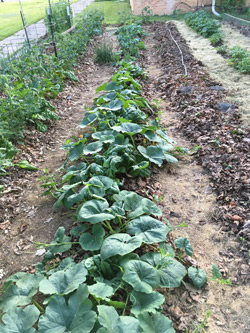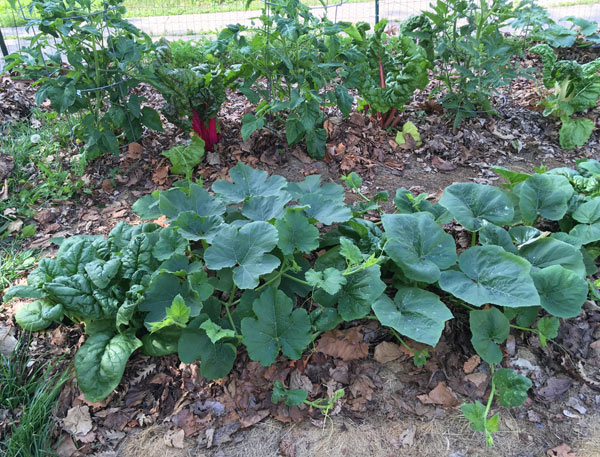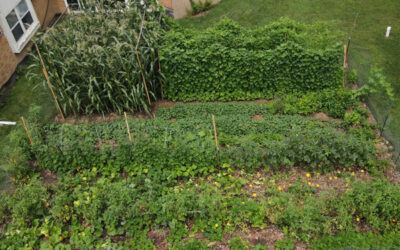I’d say, the only reason you find it hard to believe is because you haven’t tried doing it the way I do, and thus don’t have any experience base from which to judge whether it’s possible.
Of course, I have a plot measuring about 35’ x 40’ that gets at least 6-8 hours of direct sunlight per day. If you don’t have that, and still want to grow vegetables (other than lettuce and a few greens, which you can produce inside under grow lights), you’ll have to find a sunny spot any way you can. Some possibilities are a patio where you can grow potted veggies, a neighbor who might have a sunny spot they would let you use, or a community garden. Whether you live in a city, the suburbs, or a more rural area, check out local garden clubs, the nearest USDA extension office, or online gardening resources that cater to local needs to see what’s available.
Other useful resources, such as compost and mulch, may also not be as immediately available to you as they are for me, especially if you live in an urban area. On the other hand, many people throw away their raked-up lawn clippings and leaves, and would be glad to have you haul them away. Again, you have to check around to see what’s available, and adapt.
So here are the top four reasons I’m able to do it, more or less in order of importance. Which is not to say that mine is the only way. It’s just what gets me the desired results, so I stick with it until I make adjustments, which I constantly do.
1. I do it mainly for the pleasure that it brings me.
If you don’t find gardening enjoyable, you won’t do it long enough to grow some—even better—much to most of your own food. But for most people that brings up a conceptual wall: the deeply ingrained belief that only farmers using at the very least a tractor with plows and tillers can easily and efficiently feed you. That just isn’t true!. Thus the very first step to enjoyable gardening is to shed any such preconceived notions about it. Then, start small, and build as gradually as you need to keep it pleasurable every step of the way. Joy is the primary driver for a truly successful garden.
2. I invest in a good gardening spade, and I know how to use it.
 By that I mean a three and half foot long, D-handle spade with a flat, reasonably sharp, hard-steel blade about 8” wide. There are all manner of shovels and spades out there, but if you want to make enjoyable progress as efficiently as possible, go with one like this. Maybe at some point I’ll do a little video on using a spade properly—there are just a few tips and tricks, but here are the most important:• Don’t dig in soil that’s too wet (sticks to the blade) or too dry (if it’s clay-heavy soil, it will be hard, and thus extra work). A sandy, loamy soil might be easy to dig in even if it’s relatively dry.
By that I mean a three and half foot long, D-handle spade with a flat, reasonably sharp, hard-steel blade about 8” wide. There are all manner of shovels and spades out there, but if you want to make enjoyable progress as efficiently as possible, go with one like this. Maybe at some point I’ll do a little video on using a spade properly—there are just a few tips and tricks, but here are the most important:• Don’t dig in soil that’s too wet (sticks to the blade) or too dry (if it’s clay-heavy soil, it will be hard, and thus extra work). A sandy, loamy soil might be easy to dig in even if it’s relatively dry.
- When digging and turning the soil, especially in a lawn, cut only 1-2” slices, then, to achieve a looser, more crumbly “tilth,” gently chop them up with your spade when set to the side.
- Use the ground and the top edge of the blade as a fulcrum to easily pry up a slice, rather than brute force to lift it with muscle power alone.
- When lifting, have one hand on the top of the handle and the other just a few inches up from the top of the blade, then lift with your legs rather than your back.
I also have a sturdy gardening fork for loosening soil, a hoe, a pitchfork for moving mulch around, a gardening rake, and a lightweight shovel with raised edges for transferring compost. They’re definitely useful from time to time, but the most important tool, by far, is the D-handle spade.
3. I don’t dig up the whole garden.
Rather, I leave two-foot wide aisles between the rows that I don’t cultivate, with the cultivated beds only 18” wide. I either leave the aisles in grass, which I keep “mowed” with a weed-eater, or cover them with mulch (see reason 4). That way, not only is it far less work than cultivating everything, it also means I can go into the garden even after a heavy rain without sinking ankle-deep in the mud. (When it’s really wet, Iowa clay soil makes the very best, Grade A sticky, slimy mud you ever saw.) And that means sometimes I can do light garden work long before the soil is dried out enough to till. Or even just go in and walk around to admire how the plants are coming along, one of the greatest pleasures of gardening (see reason 1).
4. I mulch as heavily, and as extensively, as I need to.
 Pretty much every gardening put-down I see invokes weeding first and foremost, as if it’s the absolute bane of gardening. Which it can be, unless you use mulch, both to keep the weeds down and to keep the soil moist.
Pretty much every gardening put-down I see invokes weeding first and foremost, as if it’s the absolute bane of gardening. Which it can be, unless you use mulch, both to keep the weeds down and to keep the soil moist.
I start my mulching efforts in the fall, raking up leaves. I find the most enjoyable way to do it is to first find an area with a generous layer of leaves. Then I lay out an 8’ x 10’ lightweight plastic tarp, rake as many leaves onto it as I can, drag it to a fenced-in “leaf pen” about 8’ x 12’ (or whatever dimensions you want, as long as it holds a lot of leaves). I dump it in, load after load, until it’s full. Then I wait till the rain settles the volume down by about half, and repeat 4-5 times. Over the winter the rain and snow wet down and pack the leaves. That makes them stick together, making it easy for me to haul them out to my garden and stuff around the plants 4-6” thick.
Maybe some people think raking leaves is a drag. But for me it’s a meditative, peaceful harvest of one of nature’s free goodies. I once read where a reporter asked a Nobel prize-winning physicist what was his favorite thing to do. The answer: raking leaves. For me, it’s maybe not at the top of my favorites, but it’s right up there.
In the spring I rake up lawn clippings wherever they’re thick enough to make it worth the effort, then use either the tarp method or a wheelbarrow to haul them to the garden and apply them also a good 4-6” thick. Especially after a rain or two, when grass mulch gets packed down, almost nothing in the way of weeds, or even new grass, can get through. And eventually, both the leaves and the grass decompose and become part of the organic matter of the soil. So it’s all good.
That’s about it. All the rest is just a collection of relatively small points that any gardener will pick up with a little research, experience, and preference.





0 Comments